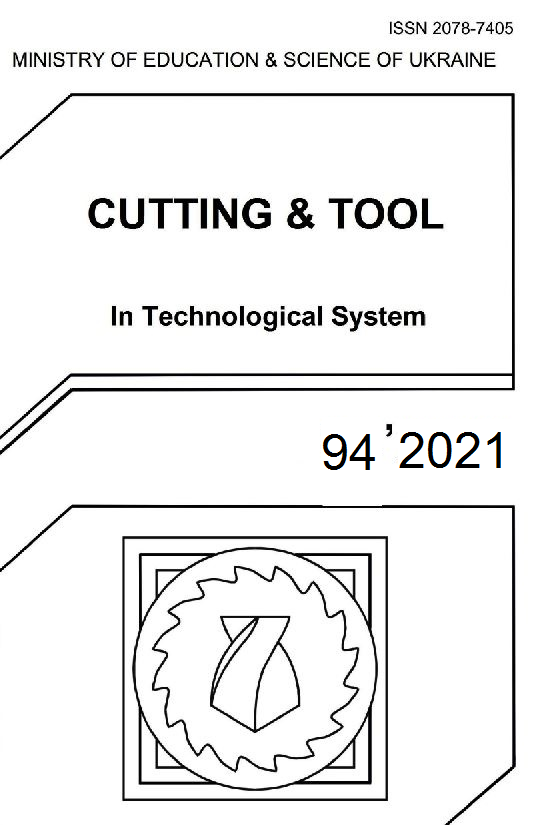SIMULATION OF THE MACHINED SURFACE AFTER END MILLING WITH SELF-OSCILLATIONS
DOI:
https://doi.org/10.20998/2078-7405.2021.94.03Keywords:
milling, self-oscillation, waviness, pitch, height, cutting surface, modelingAbstract
Thin-walled parts are widely used in the aviation industry. It is mainly carried out with end mills and is accompanied by self-oscillation during rough milling. They negatively affect the quality of the machined surface. Therefore, it is important to model it taking into account the dynamics of the milling process to predict the accuracy. In the early works of the authors, the mechanism of the profile forming of the machined surface was determined. In this case, the identity of the shape of the cutting surface and the oscillogram of part’s oscillations during milling is taken as a basis. The first wave of self-oscillations takes part in the shaping of the machined surface during cut-up milling with self-oscillation, and during cut-down milling - the last wave. The change in the distances of the cut depressions to the position of the elastic equilibrium of the part is periodically repeated from the maximum value to the minimum. Based on this, when modeling the waviness pitch of the machined surface after cut-up milling, it is necessary to know the feed rate and how many cuts were made by the tool from the largest to the smallest depression. When modeling the machined surface after cut-down milling, you need to know the length of the cutting surface. It is calculated based on cutting speed and cutting time. The formula for determining the waviness pitch after cut-down milling is derived taking into account the tool feed. The waviness height of the machined surface after cut-up and cut-down milling is determined as the difference between the largest and smallest depressions. To determine the size of the pitch and the height of the waviness, formulas are derived for converting electrical and time values of oscillograms into linear ones. These formulas also allow you to determine areas of the oscillogram with oscillations of the part during cutting and the resulting surface areas on the profilogram. The methods for modeling machined surfaces were tested after cut-up and cut-down milling with self-oscillation. In this case, the pitch and height of the waviness on the profilograms were compared with those calculated from the results of measurements of the oscillograms. Based on their analysis, refined formulas for calculating the waviness height have been derived. The error between the measurements of the waviness pitch and height and the calculated values is within 6%.
References
Vnukov Yu.N, Dyadya S.I, Kozlova Ye.B, Logominov V.A, Chernovol N.N. Self-oscillations when milling thin-walled elements of workpiece s. Zaporizhzhia: ZNTU, 2017
Svinin V.M. Milling with modulated cutting speed. ed. A.I. Promtova. Irkutsk: Publishing house Ir: TTU; 2007. 304 p.
Shapoval Yu.V, Zaloga V.O. Improving the efficiency of machining parts by control the dynamics of the turning process with high spindle speeds. BULLETIN OF ZhSTU; 2017. 2 (80). pp. 175-184. DOI: https://doi.org/10.26642/tn-2017-2(80)-175-184 pp. 175-184
Tashlitsky N.I. Primary source of energy for excitation of self-oscillations when cutting metals. Bulletin of mechanical engineering. 1960. 2. pp. 10–20
Mazur N.P, Vnukov Yu.N, Grabchenko A.I. and others. Osnovy teorii rezaniya materialov, NTU KhPI, Kharkiv. 2003. 534 p.
Zharkov I.G. Vibrations during processing with a blade tool. Mechanical Engineering, 1986. 184 p.
Dyadya S.I. Investigation of the formation of the machined surface of a thin-walled element of the workpiece during end cylindrical milling with self-oscillations. Modern Technologies in Machinery. 2017;12: pp. 5–18
Hung C.Y, Junz J.J. Wang Effects of cutting conditions on dynamic cutting factor and process damping in milling. Internation jornal of Machine Tools and Manufacture. 51, 2011. pp. 320–330
Downloads
Published
Issue
Section
License
Copyright Notice
Authors who publish with this Collection agree to the following terms:
1. Authors retain copyright and grant the Collection right of first publication with the work simultaneously licensed under a Creative Commons Attribution License that allows others to share the work with an acknowledgement of the work's authorship and initial publication in this Collection.
2. Authors are able to enter into separate, additional contractual arrangements for the non-exclusive distribution of the Collection's published version of the work (e.g., post it to an institutional repository or publish it in a book), with an acknowledgement of its initial publication in this Collection.
3. Authors are permitted and encouraged to post their work online (e.g., in institutional repositories or on their website) prior to and during the submission process, as it can lead to productive exchanges, as well as earlier and greater citation of published work.

